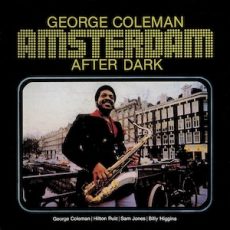
Requisites
Amsterdam After Dark ~ George Coleman | By Eddie Carter
George Coleman enters this morning’s spotlight with an excellent 1979 quartet album, Amsterdam After Dark (Timeless SJP 129). I first heard him playing alto on Houseparty and The Sermon. I later discovered he also played tenor and enjoyed his work on Eastern Rebellion, ‘Four’ and More, Maiden Voyage, Miles Davis In Europe, My Funny Valentine and Seven Steps To Heaven. This morning’s album from the library was his debut as a leader, and he composed four of the tunes. He’s joined on this date by The Hilton Ruiz Trio. Hilton Ruiz on piano and Eastern Rebellion colleagues Sam Jones on bass and Billy Higgins on drums. My copy is the original Netherlands Stereo release.
Side One opens with the trio’s introduction to the title tune, Amsterdam After Dark. George takes over and starts the fire burning on the song’s infectious melody and opening solo. Hilton sinks his teeth into the second reading, and then Sam speaks confidently, preceding the tenor’s joyful vitality in the closing chorus. Hilton Ruiz’s New Arrival picks up the quartet’s pace in an engaging opening chorus. Coleman takes flight first and builds a perfectly crafted interpretation effectively. Ruiz comes on next and is shown to great advantage in the closing statement ahead of the theme’s reprise and fadeout.
Lo-Joe is a feisty original that opens with an airy statement of the theme. George gets things going with a passionate first solo, followed by Hilton, who suggests a happy mood in the second statement. Billy’s brushwork in the closing statement swings very nicely into the foursome’s ending theme and exit. Autumn In New York by Vernon Duke is the album’s only standard. The quartet dresses up this old favorite with an intimately tender introduction and melody. Coleman’s opening statement is reflective and quite beautiful. Ruiz takes a moment for an elegantly exquisite comment leading to the leader’s delicately pretty ending.
Apache Dance is an impressive tune from the opening notes of the two-instrument conversation with tenor sax and drums, leading to a quick run of the ensemble’s theme. George unravels a lot of twists and turns in the first solo. Hilton comes right behind him, keeping his foot on the gas. Billy delivers the song’s final solo until the group reappears to take it out. Blondie’s Waltz begins with the quartet establishing an optimistic melody. Coleman starts things off with a beautifully phrased statement. Ruiz jumps in next to move things along in a lively interpretation. Higgins adds to the fun with a short spot until Coleman’s reappearance for the finale.
Wim Wigt produced Amsterdam After Dark. Bob De Caro and Jim McCurdy were the recording engineers. The album has an exceptional soundstage that comes through your speakers convincingly. If you close your eyes, it’s like the musicians are playing right in front of you. George Coleman is on fire throughout each selection, and the trio compliments him efficiently. At 88 years old, he’s showing no signs of slowing down and is still performing for jazz fans. I’ve caught a few of his performances at Smalls via their nightly streams. If you only have albums with George Coleman as a sideman, I invite you to take a trip to visit Amsterdam After Dark. It’s worth every penny for a spot in your library and is an excellent trip you can take without leaving the comfort of your chair!
~ Eastern Rebellion (Timeless SJP 101), ‘Four’ and More (Columbia CL 2453/CS 9253), Houseparty (Blue Note BLP 4002/BST 84002), Maiden Voyage (Blue Note BLP 4195/BST 84195), Miles Davis In Europe (Columbia CL 2183/CS 8983), My Funny Valentine (Columbia CL 2306/CS 9106), Seven Steps To Heaven (Columbia CL 2051/CS 8851), The Sermon (Blue Note BLP 4011/BST 84011) – Source: Discogs.com ~ Autumn In New York – Source: JazzStandards.com © 2023 by Edward Thomas Carter
More Posts: choice,classic,collectible,collector,history,instrumental,jazz,music,saxophone


